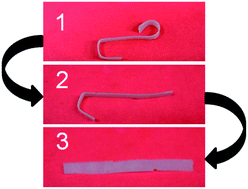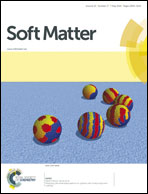Properties of triple shape memory composites prepared via polymerization-induced phase separation†
Abstract
Research in the field of shape memory polymers has recently witnessed the introduction of increasing complexity of material response, including such phenomena as triple/multishape behavior, temperature memory, and reversible actuation. Ordinarily, such complexity in physical behaviour is achieved through comparable complexity in material composition and synthesis. Seeking to achieve a triple shape behaviour with a simple route to materials synthesis, we introduce here a method that utilizes polymerization induced phase separation (PIPS) to yield the requisite combination of microstructure and composition. Thus, two blends incorporating epoxy and poly(ε-caprolactone) were developed using commercially available reactants, one featuring a semicrystalline epoxy and the other featuring an amorphous epoxy. We show that both blends exhibited distinct transition temperatures and three modulus-temperature plateaus needed for triple shape behaviour. Despite these similarities, their physical character at room temperature is vastly different: the semicrystalline epoxy material is elastomeric and the amorphous epoxy material is highly stiff. Characterization of the triple shape behaviour revealed an ability of both systems to fix two separate deformations independently, one by PCL crystallization and a second one by epoxy crystallization or vitrification, and recover both programmed shapes separately upon heating. Given the simplicity of fabrication, we envision application as multi-shape coatings, adhesives, and films.


 Please wait while we load your content...
Please wait while we load your content...